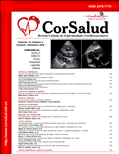Incessant right ventricular outflow tract tachycardia - Tachycardiomyopathy? The enigma
Abstract
Long-lasting or incessant ventricular tachycardias may cause heart failure, left ventricular dysfunction, and cardiomyopathy; conditions that reverse once the arrhythmias have been solved. This is a diagnosis of exclusion: there may be a basic heart disease that worsens with the tachycardia and it must be clarified whether the arrhythmia leads to cardiomyopathy (there may be an underregistration) or vice versa. A patient with incessant right ventricular outflow tract tachycardia, with long evolution, hemodynamic repercussion, dilated cardiomyopathy and severe dysfunction of the left ventricle, refractory to antiarrhythmic drugs and with two failed ablations, pending endomyocardial biopsy and new ablation of his tachycardia is presented. Some clues to differentiate right ventricular outflow tract arrhythmias, in their benign (most frequent) and malignant variants, are discussed. Some clues to differentiate them are: the duration of the QRS complex, the coupling interval of premature contractions and the heart rate of the tachycardia.
Downloads
References
1. Huizar JF, Ellenbogen KA, Tan AY, Kaszala K. Arrhythmia-induced cardiomyopathy: JACC State-of-the-Art Review. J Am Coll Cardiol. 2019;73(18):2328-44.
2. Ellis ER, Josephson ME. What about tachycardia-induced cardiomyopathy? Arrhythm Electrophysiol Rev. 2013;2(2):82-90.
3. Boukens BJ, Coronel R, Christoffels VM. Embryonic development of the right ventricular outflow tract and arrhythmias. Heart Rhythm. 2016;13(2):616-22.
4. Kim RJ, Iwai S, Markovitz SM, Shah BK, Stein KM, Lerman BB. Clinical and electrophysiological spectrum of idiopathic ventricular outflow tract arrhythmias. J Am Coll Cardiol. 2007;49(20):2035-43.
5. Viskin S, Antzelevitch C. The cardiologists' worst nightmare: sudden death from “benign” ventricular arrhythmias. J Am Coll Cardiol. 2005;46(7):1295-7.
6. Kurosaki K, Nogami A, Shirai Y, Kowase S. Positive QRS complex in lead I as a malignant sign in right ventricular outflow tract tachycardia. Comparison between polymorphic and monomorphic ventricular tachycardia. Circ J. 2013;77(4):968-74.
7. Shimizu W. Arrhythmias originating from the right ventricular outflow tract: how to distinguish “malignant” from “benign”? Heart Rhythm. 2009;6(10):1507-11.
8. Capulzini L, Brugada P, Brugada J, Brugada R. Arritmias y enfermedades del corazón derecho: de las bases genéticas a la clínica. Rev Esp Cardiol. 2010;63(8):963-83.
9. Maury P. Why is the right ventricular outflow tract so arrhythmogenic? (… or is it really?...). Heart. 2011;97(20):1631-3.
10. Viskin S, Rosso R, Rogowski O, Belhassen B. The "short-coupled" variant of right ventricular outflow ventricular tachycardia: a not so-benign form of benign ventricular tachycardia? J Cardiovasc Electrophysiol. 2005;16(8):912-6.
11. Noda T, Shimizu W, Taguchi A, Alba T, Satomi K, Suyama K, et al. Malignant entity of idiopathic ventricular fibrillation and polymorphic ventricular tachycardia initiated by premature extrasystoles originating from the right ventricular outflow tract. J Am Coll Cardiol. 2005;46(7):1288-94.
12. Pieroni M, Notarstefano P, Ciabatti M, Nesti M, Martinese L, Liistro F, et al. Electroanatomic mapping-guided endomyocardial biopsy in patients with apparently idiopathic ventricular arrhythmias. Pacing Clin Electrophysiol. 2020;43(9):1028-38.
13. Pieroni M, Notarstefano P, Oliva A, Campuzano O, Santangeli P, Coll M, et al. Electroanatomic and pathologic right ventricular outflow tract abnormalities in patients with Brugada syndrome. J Am Coll Cardiol. 2018;72(22):2747-57.
14. Corrado D, Basso C, Leoni L, Tokajuk B, Turrini P, Bauce B, et al. Three-dimensional electroanatomic voltage mapping and histologic evaluation of myocardial substrate in right ventricular outflow tract tachycardia. J Am Coll Cardiol. 2008;51(7):731-9.
15. Martini B, Martini N, Dorantes Sánchez M, Márquez MF, Zhang L, Fontaine G, et al. Pistas de una enfermedad orgánica subyacente en el síndrome de Brugada. Arch Cardiol Mex. 2017;87(1):49-60.
16. Santangelli P, Pieroni M, Dello Russo A, Casella M, Pelargonio G, Di Biase L, et al. Correlation between signal-averaged ECG and the histologic evaluation of the myocardial substrate in right ventricular outflow tract arrhythmias. Circ Arrhythm Electrophysiol. 2012;5(3):475-83.
Downloads
Published
How to Cite
Issue
Section
License
Authors who publish with this journal agree to the following terms:- Authors retain copyright and grant the journal right of first publication with the work simultaneously licensed under a Creative Commons Attribution License that allows others to share the work with an acknowledgement of the work's authorship and initial publication in this journal.
- Authors are able to enter into separate, additional contractual arrangements for the non-exclusive distribution of the journal's published version of the work (e.g., post it to an institutional repository or publish it in a book), with an acknowledgement of its initial publication in this journal.










